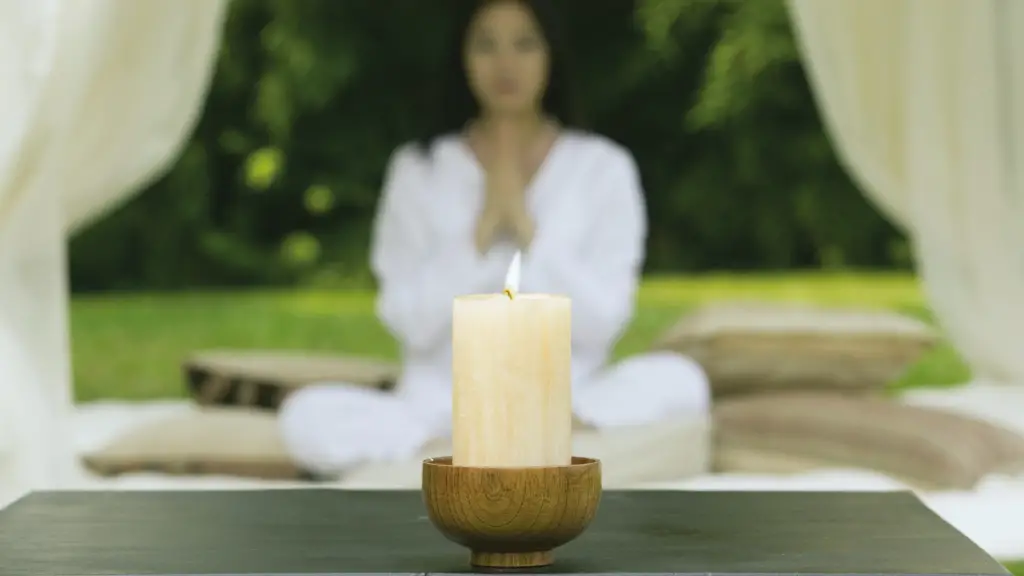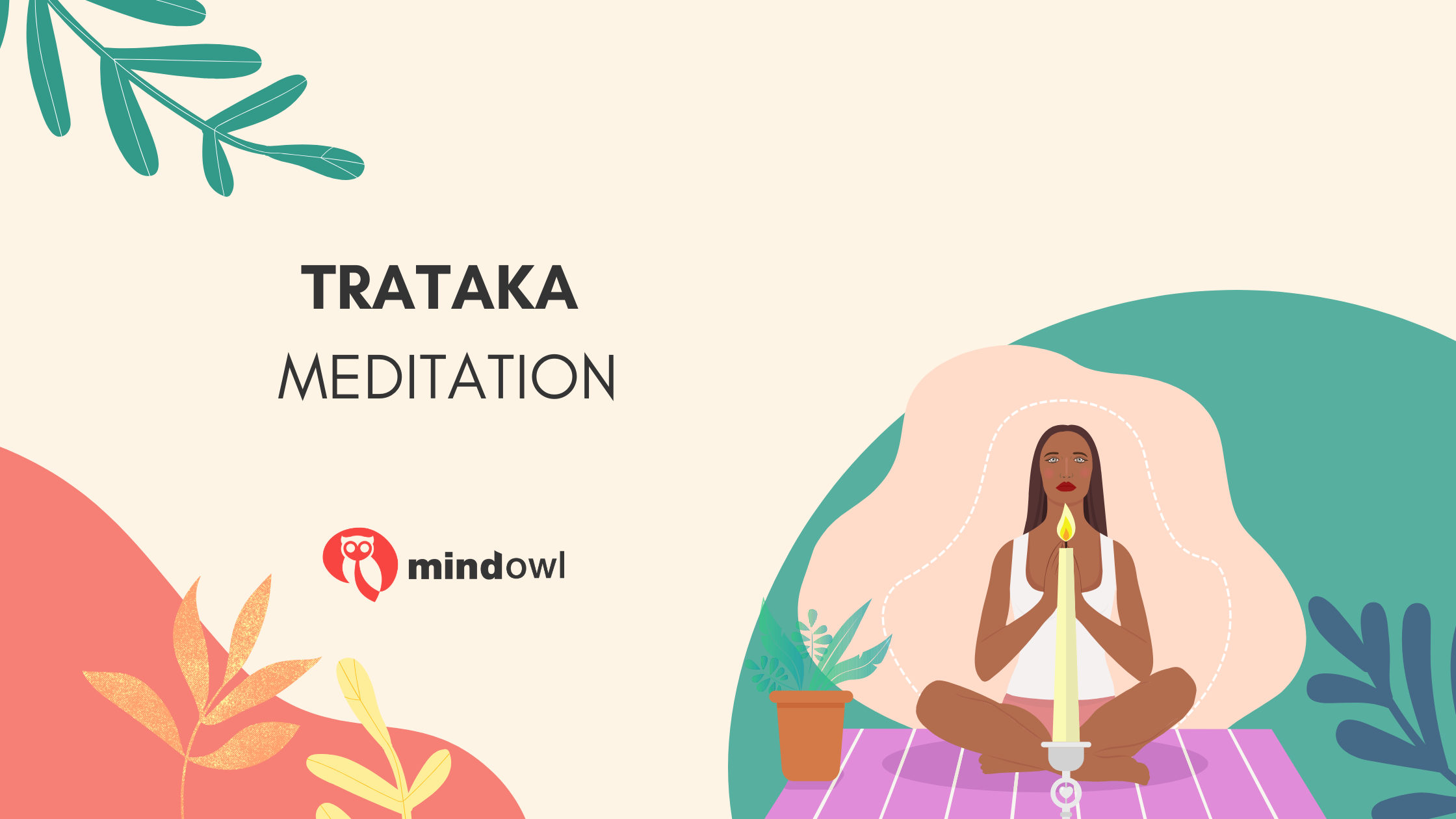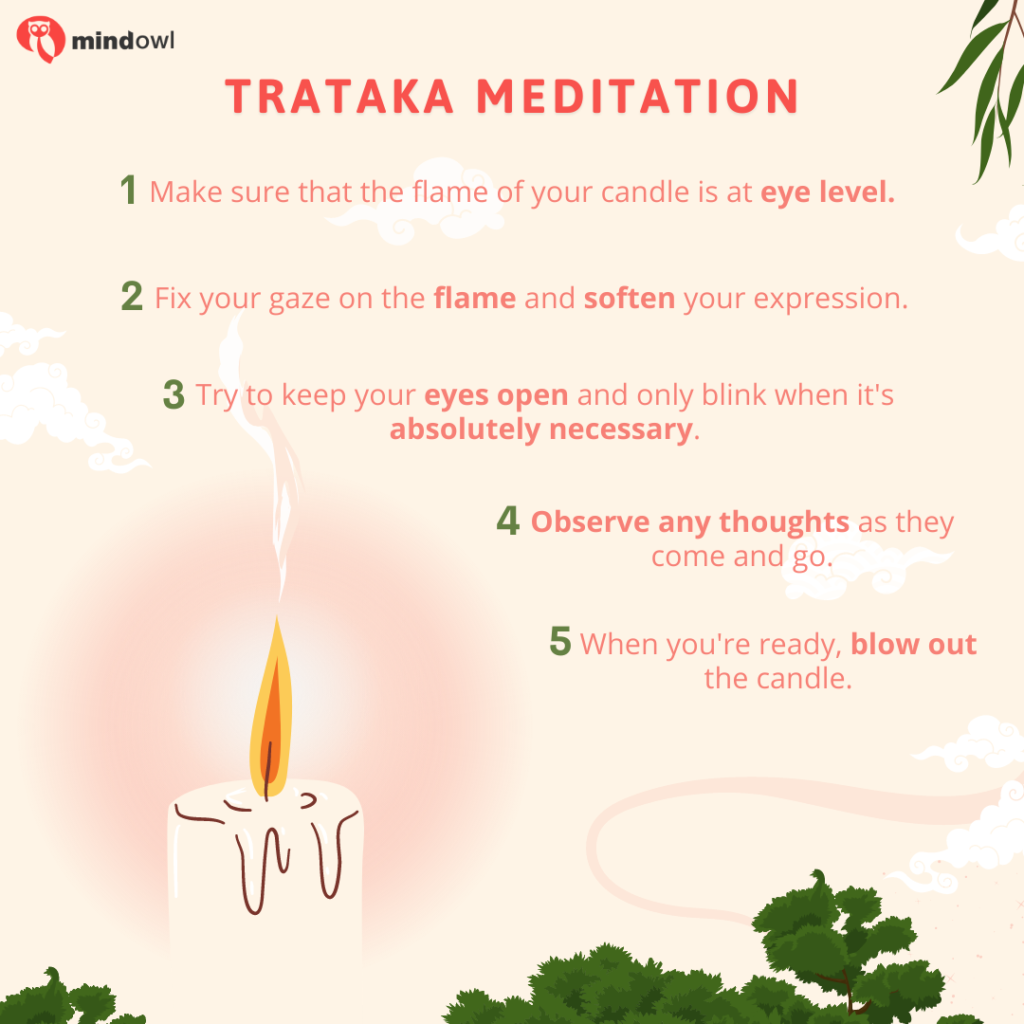Meditation is usually done with the eyes closed. Keeping the eyes shut during practice can allow meditators to focus their attention inwards, remove external distractions and exert a kind of healthy control over their minds. Trataka is a meditation technique which has a similar goal, but a different approach. This form of meditation attempts to still the mind using the power of sight.
What Is Trataka Meditation?
Trataka may not be a term that you’ve come across before, but it’s possible that you’ve seen examples of it before, either online, in person, or in films and TV. Essentially, this is a ritual-like form of candle meditation in which participants gaze into a flame for an extended period of time, in order to produce tears and thereby reach a state of increased clarity.
According to the ancient Sanskrit text The Hatha Yoga Pradipika, this practice involves “looking intently with an unwavering gaze at a small point until tears are shed.” A number of meditative objects can be used, including the tip of your nose, a mark on the wall, or a star in the sky, but a candle flame would be the traditional object of focus.
The practice of Trataka Meditation has been associated with a number of benefits, including enhanced concentration, reduced stress and anxiety, and increased focus — but we’ll discuss these benefits in more detail later. First, let’s explore the origins of Trataka Meditation, and consider how this ritual has expanded beyond its roots in Asia to gain popularity across the world today.

The Origins Of Trataka
Like other forms of meditation including Neti Neti and Pranayama, the term for this meditation practice derives from the Sanskrit language, in which “Trataka” means “to gaze”, or “to gaze steadily”. First communicated via the Hatha Yoga Pradipika, an ancient yogic text written by Svatmarama in the 15th century, this practice was traditionally intended to help purify the body in preparation for a path towards higher meditation. It has strayed slightly from these roots, but the idea behind Trataka Meditation remains the same.
Despite the fact that nearly half of the brain is dedicated to vision, our eyes are an area of the body that is often neglected within meditation. Trataka seeks to counteract this tendency, guided by the idea that the gaze can be a great tool for quietening the mind.
The type of vision employed within Trataka is sometimes viewed as passive; however, the use of an external object as a central focus means that this practice can be great for cultivating clarity, improving focused attention skills and tuning out of distractions.
The Different Types Of Trataka Meditation
There are two main forms of Trataka Meditation. Bahiranga Trataka (or External Trataka) is an external practice which asks participants to simply gaze outwards at an object or symbol. On the other hand, Antaranga Trataka (or Internal Trataka) involves clear and stable inner visualisation of an object.
Bahiranga Trataka is seen as an easier form of the practice, because it revolves largely around gazing at a candle, while Antaranga sessions encourage practitioners to visualise their meditative object without looking at it. Bahiranga Trataka is the more common variety, so that’s what our guided session, later on, will lean towards. But before we get to that, let’s explain some of the main benefits that attract people to Trataka Meditation.
What Are The Benefits Of Trataka?
Ever-growing scientific interest in meditation has led to several research projects into Trataka meditation and its benefits.
Scientific studies have backed up Trataka’s ability to reduce anxiety, tension and depression, decrease pulse rate, and boost concentration and memory. Trataka advocates like the Yoga Institute also claim that the practice can strengthen eye muscles and improve vision. The practice is said to have a cleansing effect on both the eyes and the cerebral cortex, balancing the nervous system and relieving the symptoms of insomnia, as well as other mental health issues.
According to a study led by Shubhada Talwadkar, Trataka meditation can also have positive effects on the cognitive functions of the elderly, with a month-long period of daily Trataka practice causing improved cognitive abilities amongst test subjects.
But it’s not just the elderly who can benefit from this meditative practice. The steadied gaze and focused attention that Trataka encourages can be great for people with a short attention span, or those who really struggle to control their wandering minds. Choosing a physical object to concentrate on can increase focus and cause invasive thoughts and distractions to fade away.
Sounds pretty useful, right?
It’s true that numerous benefits have been cited in relation to this meditation practice. So how exactly does it work? It’s time for a short guide on how to practise Trataka meditation.
How do you practise Trataka?
Like most yoga practices, Trataka requires a peaceful setting with limited distractions. It is recommended that Trataka be practised in a dark room in which a single candle is the main source of light. In order to encourage concentration while avoiding eye strain, perform this candle meditation with the flame around 2 feet away from you. Before getting started, it’s worth thinking about the type of candle you’re going to use as your object of focus.
Selecting a Candle
Any type of candle can be used for this form of meditation, although there are a few things worth bearing in mind before you start your session. For example, soy or beeswax candles are ideal, because they’re non-toxic and burn longer than other candle types. Some candles will give off a bright light, while others will emit a dim light; this choice comes down to individual preference.
The colour of your candle can also have an impact, with certain colours being associated with different qualities, attributes and cognitive functions. White, for instance, is associated with purity, clarity and simplicity, while gold candles are associated with abundance and prosperity, and red candles with courage, strength and vitality.
Okay, now that you’re familiar with all the basics, let’s look at some simple steps for how to complete a Trataka session.
- Set a timer for however long you want your session to be. To begin with, it’s best to go for 2-3 minutes, and gradually work your way up to 10-15 minutes of practice over time.
- Settle into a comfortable position, either on a chair or a cushion on the floor. Try to make sure that the flame of your candle is at eye level.
- Fix your gaze on the flame and allow your expression to soften.
- Try to keep your eyes open and only blink when it’s absolutely necessary. Be careful here though; blinking is a protective mechanism, and it’s important not to over-strain your eyes.
- Observe any thoughts as they come and go, trying not to get attached to them.
- Begin to close your eyes and try to keep the image of the flame at the forefront of your mind. Visualise the flame in the centre of your brow, trying to keep an even and steady focus on this meditative object.
- Continue doing this until your timer goes off, at which point you can bring yourself back to the present moment and take in your surroundings.
- When you’re ready, blow out the candle and take a minute to think about how you feel.
Exercises To Use Alongside Trataka
There are a couple of eye care exercises that go hand in hand with Trataka meditation. These can be particularly useful in the immediate aftermath of a session.
Cupping or Palming the Eyes – This is a great way to relax the eyes and restore mental balance and emotional regulation after the intensity of a Trataka session. Gently rub your palms in order to generate some heat, before placing the palms on your eyes, ‘cupping’ and shielding them. Hold this position for 5 to 10 seconds, and then repeat as many times as you’d like.
Eyewash – Splashing your eyes with water can be nice and refreshing, but this eyewash technique provides a deeper cleanse after a Trataka session. To perform an eyewash, take some room temperature drinking water in one palm, and dip your eye into it for a few seconds. Blink a couple of times while submerged in water, before repeating with your other eye.
Can Trataka Meditation Have Any Adverse Effects?
We’ve been through the potential benefits of Trataka; it can improve cognitive functions and cognitive flexibility, reduce anxiety and tension, and enhance executive functions such as memory, particularly for older people. But are there any adverse effects that practitioners should be aware of?
Well, it’s important to note that the eyes are an extremely sensitive part of the body, as most people are aware. For that reason, most Trataka advocates suggest that beginners start by only practising this method for 2 minutes, before gradually working up to 10-15 minute sessions. Following this incremental path will allow your eyes to adjust to the demands of the practice. Like most varieties of mindful meditation, it’s sensible to start small and move forwards from there.
While Trataka is generally safe if only practised for a short period of time, this practice does carry the risk of potentially causing eye damage. Participants should make sure that they close their eyes, cup them or palm them once they start watering and producing tears; this point represents the culmination of the gazing exercise, and continuing for longer could be dangerous.
Closing your eyes at this point also offers a good opportunity to practise internal Trataka, in which you attempt to visualise your object of focus rather than just gazing at it.
To Conclude
If you follow these basic safety steps and ensure that your Trataka sessions are short, focused, and highly intentional, it’s likely that you will experience some of the benefits this practice offers in terms of improving cognitive functions, heightening awareness and experiencing real calmness.
One of the best things about Trataka Meditation is that you can practise it at home in your own time; in fact, it offers a great opportunity for you to sit down in a calming atmosphere and strive towards a state of true equanimity and balance. If you’ve only ever used anchors such as the breath or parts of the body during meditation, you may find it useful to turn your attention towards the bright light of a candle flame.
Interested in finding out some more methods for cultivating inner peace? Check out our article on how to have a peaceful mind.
MindOwl Founder – My own struggles in life have led me to this path of understanding the human condition. I graduated with a bachelor’s degree in philosophy before completing a master’s degree in psychology at Regent’s University London. I then completed a postgraduate diploma in philosophical counselling before being trained in ACT (Acceptance and commitment therapy).
I’ve spent the last eight years studying the encounter of meditative practices with modern psychology.




One thought on “Trataka Meditation: An Ancient Technique For Relaxation”